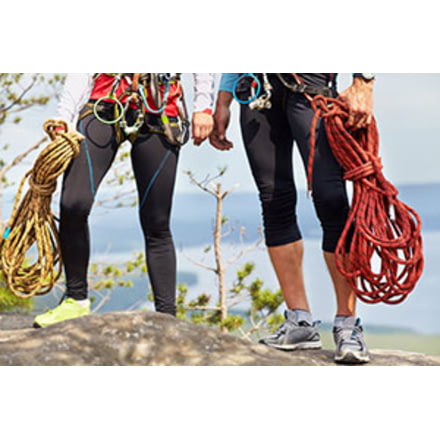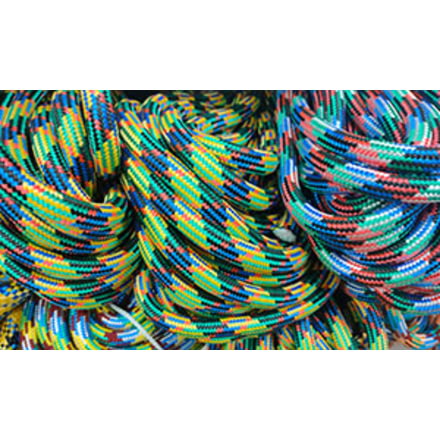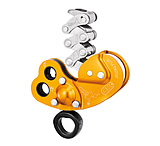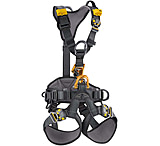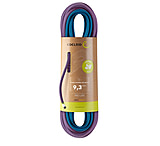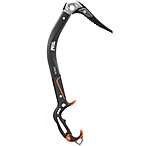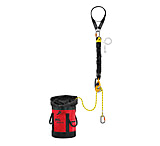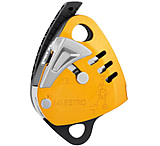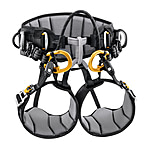Static Ropes vs. Dynamic Ropes
Rappelling or abseiling is best done with a static or dynamic rope with low elasticity. A static rope is a low-elongation rope with minimal stretch when placed under a load of less than 5%. Static elongation refers to the amount a rope stretches with an 80kg weight hanging from it. Lead climbing must be done with a dynamic rope.![]()
A dynamic rope is an elastic rock climbing rope used in rock climbing, ice climbing, and mountaineering. Dynamic ropes are designed to stretch up to 40%. They come in a variety of lengths and diameters, with the most common lengths being 50 meters (164.0 ft), 60 meters (200 ft), 70 meters (230 ft), and 80 meters (262 ft). Dynamic rope reduces the amount of force on the rope and, thus, the probability of the rope's catastrophic failure. This stretch allows a dynamic rope to absorb the energy of a sudden load more slowly, such as a climber falling. Today's most common dynamic rope is kernmantle rope, constructed with its interior core protected by a woven exterior sheath designed to optimize strength, durability, and flexibility.
Single Ropes vs. Half Ropes vs. Twin Ropes
Using any climbing rope is essential only to use it as designed and tested. Dynamic climbing ropes are classified into three categories: single ropes, twin ropes, and half ropes.
Single Ropes
Single ropes come in a wide range of diameters and lengths, making them suitable for various climbing disciplines such as trad climbing, sport climbing, big-wall climbing, and top roping. They are easier to use than two rope systems. Single ropes are meant to be used alone and not with another climbing rope, as some other rope types are. Some single ropes are also rated as half and twin climbing ropes. Single climbing ropes are great for beginner rock climbers just starting out. Single climbing ropes are marked with a circled one (“1”) symbol on the end of the rope.
Half Ropes (Double Ropes)
When climbing with half ropes, the climber uses two half ropes. On the ascent, the climber clips one rope to protection on the left and the other to safety on the right. When done correctly, the climber has the ropes run parallel and straight, reducing rope drag on wandering routes.
Half ropes are used for trad climbing, wandering multi-pitch rock routes, mountaineering, and ice climbing. Climbers wandering want to use a half rope technique to reduce rope drag. Tying two half ropes together when rappelling will allow the climber to rappel twice as far rather than using a single rope. Half ropes can also help if one is damaged by a cut or fall.
Half rope techniques are more complicated than using a single climbing rope correctly; they require more skill and effort since the climber climbs and belays with two ropes. Using two half ropes is heavier than a single rope; however, the weight is balanced with two climbers. Climbers should not mix and match half ropes; they have a circled half (“½”) symbol on each rope's end.
Twin Ropes
Similar to half-climbing ropes, twin ropes are a two-rope system. The difference with twin ropes is the climber must always clip both strands through each piece of protection, just as you would with a single climbing rope. However, there is more rope drag with twin ropes. Twin ropes are also thinner and lighter than other ropes. This means twin ropes are a good option for climbers trad climbing on non-wandering multi-pitch rock routes, mountaineering, and ice climbing. A benefit of a twin rope setup is that the rope's weight can be distributed between 2 climbers on the way to and from the crag (each carries one lighter rope instead of one climber carrying the single heavier rope).
Twin ropes have two circles overlapping, similar to a Venn diagram. Some triple-rated ropes can be used as a twin, half, and single ropes for maximum versatility. It's essential to use only a rope as it was designed and tested.
Rope Length & Rope Diameter
The rope's diameter and length affect its weight and durability. Standard climbing rope lengths are 70 meters long or 230 feet. A longer rope is just used for routes that are taller because when your belayer lowers you after the climb, the rope is doubling up, so you can only lower half the distance of the rope length (with a 70m rope, you can't climb something longer than 35m because when you are lowering you wouldn't be able to reach the ground). Most multi-pitch routes usually still have each individual pitch not being that long to require a rope longer than 70m. A longer rope just might allow for descending in fewer rappels since the distance you can cover per rappel would be longer. However, the longer the rope, the heavier it is.
You'll want a skinnier, lighter rope if you're hiking long distances for multi-pitch climbs. Generally speaking, thinner ropes are more lightweight; however, they can be less durable and require more skill to belay safely. Thicker ropes can be more abrasion-resistant and often stand up to frequent use. Climbers top roping at the local crag will want a climbing rope with a diameter.
Rope Features
Dry-Treated Rope
Dry-treatment climbing ropes reduce water absorption. When something absorbs water, it gets heavier; it is no different when climbing ropes get wet. If the climber is going to be sport climbing or shorter climbs and using preplaced bolts, it is done anywhere, outdoors, or inside a gym climbing, and does not generally need dry treatment ropes. However, some climbers like to use a dry-treated rope when indoor climbing because it helps with abrasion resistance. Trad climbers, ice climbers, and mountaineers who are more likely to encounter wet conditions such as rain, snow, or ice will need to use dry-treated ropes. Dry-treated ropes can have a dry sheath, dry core, or both: the more dryness protection, the better against moisture absorption.
Middle Mark & End Warning Marks
End warning marks let the climber know where the rope's end is. A middle mark sounds exactly like it is: the middle of the climbing rope. A black dye marks these ropes; this is important for rappelling.
Bi-Pattern & Bi-Color
Bi-pattern and bi-color climbing ropes either have a color weave change or color change at the middle point of the rope for rappelling. The bi- pattern (and the middle mark) helps the belayer identify the middle on a longer route. This is important because if a climber continues past the point where the belayer passes the middle, there won't be enough rope length left for the climber to lower. The rope doubles up when lowering. Half of the rope goes up to the anchor, and half goes down attached to the climber.
Safety Ratings
The Union Internationale des Associations d'Alpinisme (UIAA) is known in the United States as the International Climbing and Mountaineering Federation. It is the international governing body of climbing and mountaineering. It represents climbers and mountaineers worldwide on many issues related to mountain safety standards, sustainability, and competitive sports.
UIAA Fall Rating
The UIAA tests climbing ropes to see how many falls they can hold before failing. Ropes that meet the UIAA fall rating standard are safe for rock climbing. A climbing rope's higher fall rating will last longer and is more durable.
UIAA tests recommend that single ropes are tested by dropping an 80kg weight onto the rope. Half ropes are tried by dropping a 55kg weight on a single strand, and twin ropes are tested by dropping an 80kg weight on two strands. Single ropes and half ropes must withstand a minimum of 5 UIAA falls. Twin ropes must withstand a minimum of 12 UIAA falls.
Shop Climbing Ropes at Campsaver!
At Campsaver, we carry climbing ropes, whether you are sport climbing, trad climbing, mountaineering, or ice climbing. Campsaver carries dynamic and static ropes in various lengths and diameters to fit your climbing needs. Shop brands such as Petzl, Beal, Black Diamond, and more!
